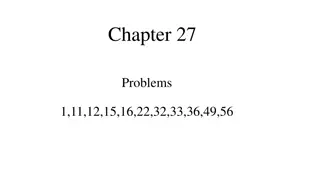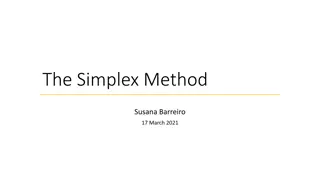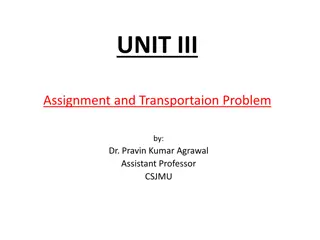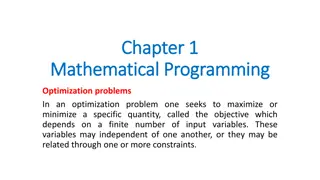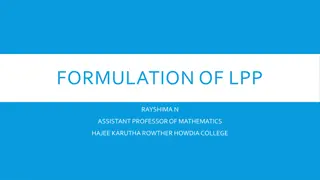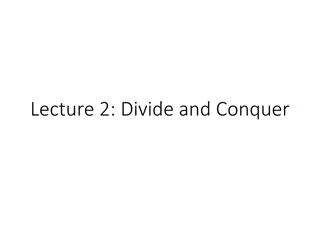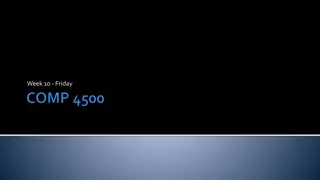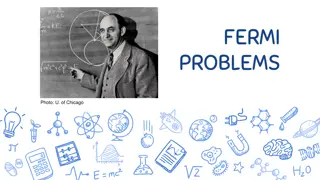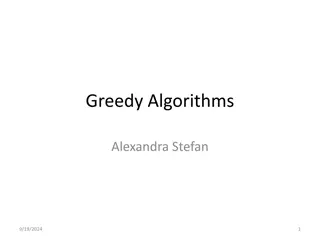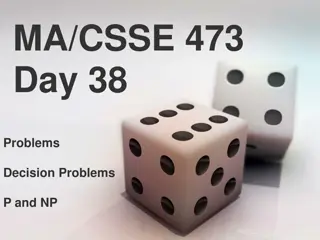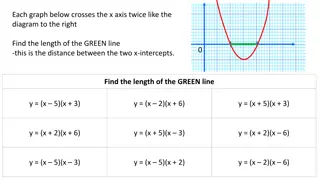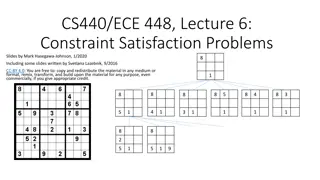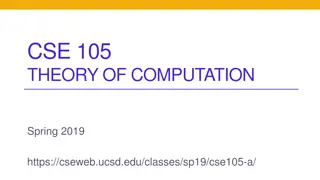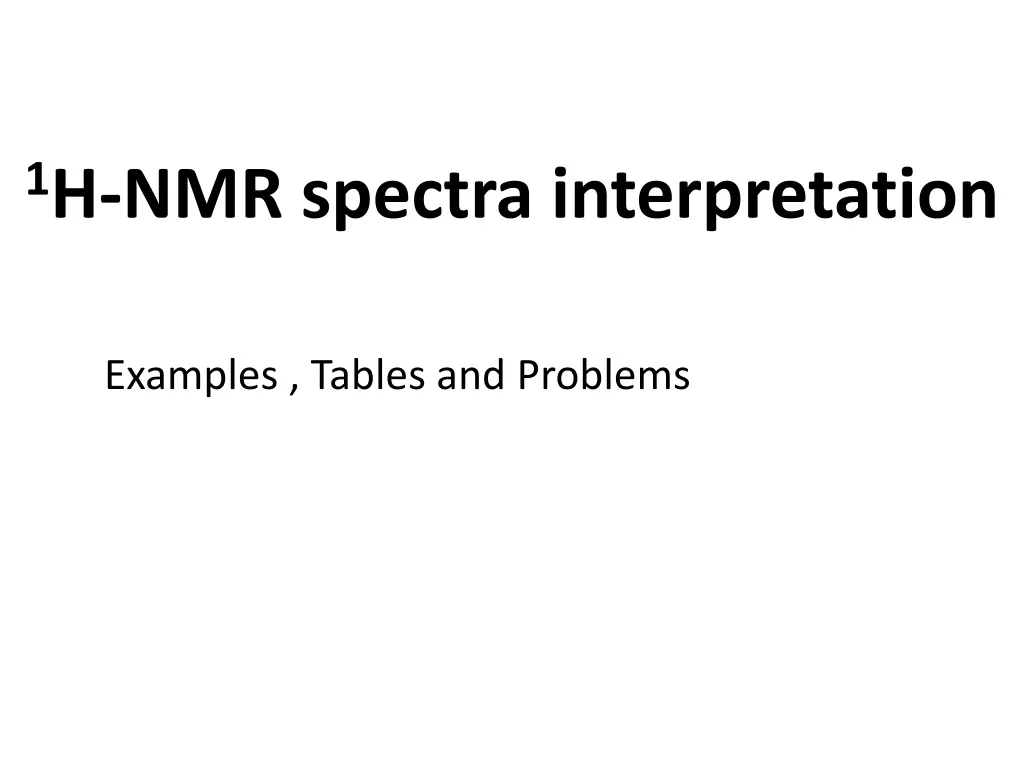
Interpreting 1H-NMR Spectra: Examples, Tables, and Problems
Explore examples, tables, and problems related to interpreting 1H-NMR spectra, including chemical shifts, types of hydrogen, and functional groups. Learn how to analyze signals, areas, and splitting patterns in the spectra of compounds like p-xylene, tert-butyl bromide, and ethyl bromide. Images and detailed information provided.
Download Presentation

Please find below an Image/Link to download the presentation.
The content on the website is provided AS IS for your information and personal use only. It may not be sold, licensed, or shared on other websites without obtaining consent from the author. If you encounter any issues during the download, it is possible that the publisher has removed the file from their server.
You are allowed to download the files provided on this website for personal or commercial use, subject to the condition that they are used lawfully. All files are the property of their respective owners.
The content on the website is provided AS IS for your information and personal use only. It may not be sold, licensed, or shared on other websites without obtaining consent from the author.
E N D
Presentation Transcript
1H-NMR spectra interpretation Examples , Tables and Problems
Nuclear Magnetic Resonance 1H-nmr spectrum: Chemical Shift
Chemical Shift ( ) Type of Hydrogen Type of Hydrogen Chemical Shift ( ) (CH3)4Si RCH3 RCH2R R3CH R2C=CRCHR2 0 (by definition) 0.8-1.0 1.2-1.4 1.4-1.7 O RCOCH3 3.7-3.9 O RCOCH2R 4.1-4.7 3.1-3.3 1.6-2.6 2.0-3.0 2.2-2.5 2.3-2.8 RCH2I RC CH RCH2Br 3.4-3.6 3.6-3.8 4.4-4.5 4.5-4.7 ArCH3 ArCH2R RCH2Cl RCH2F ArOH ROH RCH2OH 0.5-6.0 3.4-4.0 3.3-4.0 0.5-5.0 R2C=CH2 4.6-5.0 5.0-5.7 6.5-8.5 RCH2OR R2NH R2C=CHR ArH O O RCCH3 O RCCH2R 2.1-2.3 RCH O 9.5-10.1 2.2-2.6 RCOH 10-13 Electroneg- ativity of X Chemical Shift ( ) Type of Hydrogen (R = alkyl) Name of Hydrogen Chemical Shift ( ) CH3-X CH3F 4.0 3.5 3.1 2.8 2.5 4.26 3.47 3.05 2.68 2.16 0.86 0.00 RCH3, R2CH2, R3CH R2C=C(R)CHR2 RC CH Alkyl 0.8 - 1.7 1.6 - 2.6 CH3OH CH3Cl CH3Br CH3I (CH3)4C (CH3)4Si Allylic Acetylenic Vinylic Aldehydic 2.0 - 3.0 R2C=CHR, R2C=CH2 RCHO 4.6 - 5.7 9.5-10.1 2.1 1.8
How 1H NMR spectrum for p-xylene will appear? p-xylene H3C CH3 How many H type are their? This will inform us the number of signals in the spectra How many H atoms in each type? This will inform us the area of each signal What are the functional groups near each H type? This will inform us where the signal will appear (chemical shift ) How many H atoms are attached to the carbon atom s nearby each H type? This will inform us how the splitting pattern will appear for each signal
How 1H NMR spectra for p-xylene will appear? p-xylene H3C CH3 a a b a 6H at about 2.2 ppm singlet b 4H at about 7.0 ppm singlet
How 1H NMR spectra for tert-butyl bromide will appear? CH3 H3C C CH3 Br tert-butyl bromide a singlet 9H at about 1.8ppm
How 1H NMR spectra for ethyl bromide will appear? a b CH3CH2-Br ethyl bromide a triplet 3H b quartet 2H
Draw the chemical structure for the compound Number of signals in the spectra will inform us the number of H type in the molecule will inform us the number of H atoms in each type Area of each signal Chemical shift of the signal will inform us about closeness of H type to the functional group Splitting pattern for each signal will inform us how many H atoms surrounding each type
Draw the chemical structure for the compound C3H7Br a triplet 3H b complex 2H c triplet 2H c b a
Draw the chemical structure for the compound C3H7Br o C3H7Br has IHD = 0 no unsaturation (no double bonds nor cycles), so it is chain molecule (straight or branched). o From the given data, there are three signals (a, b and c) so there are three types of H atoms, each type will be at a unique carbon atom. o It is obvious that there is no symmetry in the molecule, the formula has 7H atoms and they are distributed on three separate signals (3+2+2). We have CH3 , CH2 and CH2 c a b o c signal has the higher value (more deshielded atoms), this mean that this H type of atoms are the nearest to the Br atom. We could use tables to check for this, so c signal should be like this CH2 Br c o The splitting pattern shows that a signal is triplet, this mean that it has only 2H atoms surrounding it, so this side of the molecule will be CH3 CH2 because it has only one side to attach with. a o Now, the final touch, the like between the tow ends, it is the b hydrogens. This will form CH3 CH2 CH2 Br. This justify the splitting patterns for b and c. a b c
Draw the chemical structure for the compound C3H7Br 1-bromopropane a b c CH3CH2CH2-Br a triplet 3H b complex 2H c triplet 3H
Try the same methodology for C3H7Cl spectra below a doublet 6H b septet 1H b a Answer: isopropyl chloride
Draw the chemical structure for the compound C4H9Br a triplet 3H b doublet 3H c complex 2H d sextet 1H
Draw the chemical structure for the compound C8H9Cl a singlet 3H b singlet 2H c ~ singlet 4H
Draw the chemical structure for the compound C2H6O a triplet 3H b singlet 1H c quartet 2H
Draw the chemical structure for the compound C8H10 a triplet 3H b quartet 2H c ~singlet 5H
Draw the chemical structure for the compound C6H14O a triplet 6H b complex 4H c triplet 4H
Draw the chemical structure for the compound C10H14 a triplet 6H b quartet 4H c singlet 4H
Draw the chemical structure for the compound C5H11Br a triplet 3H b singlet 6H c quartet 2H b & c overlap
Draw the chemical structure for the compound C3H8O a triplet 3H b complex 2H c singlet 1H d triplet 2H
Draw the chemical structure for the compound C11H16 a 9H = 3CH3, no neighbors 9H c 5H = monosubstituted benzene b 2H, no neighbors 2H 5H
Draw the chemical structure for the compound C4H8Br2 6H a = 6H, two CH3 with no neighbors (CH3)2C b = CH2, no neighbors & shifted downfield due to Br 2H
C7H8O c = monosubst. benzene b = CH2 5H c = OH 2H 1H



